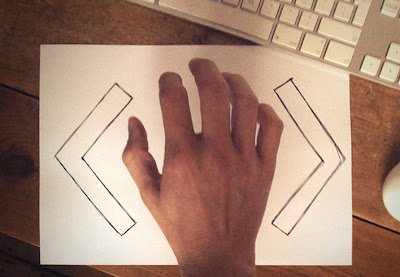1: Simple
2: Intuitive
3: Discoverable
And for bonus points:
4: Delightful
If i've just bought a new microwave and I can't heat my sponge pudding within five minutes of plugging it in, I'll be sad and hungry. Give me some simple dials that denote 'time' and 'power' and I will happily know exactly what these mean, given that they directly correspond to the heating instructions on the back of the packet. If you don't give me these, give me some clear iconography - semiotically understandable so I can jolly well start heating. If I find myself in front of a dial sporting a graphic with which I've no prior experience, allow me to discover its function painlessly - discovery is a rewarding experience, which in turn creates satisfaction. Throw in a 'delighter' - say a good old-fashioned analogue 'ting' rather than the digital beep of the surly robot meal generator - and you're on to a winner, and I'm on to my pudding.
Recently I saw something excellent. My favourite teeny weeny bit of design I've seen for ages. An instructions killer which, if it already exists, I've never personally experienced it before.
Everyone's hooted and tweeted about the Being Henry campaign for Range Rover Evoque, and rightly so. It's a quite beguiling and seamless piece of brand engagement with the sort of rabbit warrens it's a pleasure to spend time down. The campaign is quite straightforward stuff, guiding a guy called Henry throughout his day by making this-or-that choices for him at pivotal moments in the story. You get to act like a God. A God that manages to have time to spend messing about on the internet when He/She has better things to do. But a God nonetheless.
The crux of the interaction within the Henry experience lies not in the user clicking choices presented to them, but rather dragging Henry either left or right in the direction of his next adventure. This action of dragging isn't remarkable or unique (I've worked on an interactive piece myself which used a similar device) but the way the user is introduced to it is clever. Really clever.
Before the user reaches the main bit of Being Henry they face the usual language select gateway. With any other campaign, this is just another fait accompli before the main experience. But in this case, an otherwise dull screen becomes a neat little tutorial without the user even realising they've been tutorialised. Rather than click your language, you drag a slider left or right until your language slots into place. Before you've even started, you're familiar with the navigational mechanism ahead.

For such a little nudge it reaps big rewards. It's simple, it's intuitive, it's discovery. The endeavour of choosing a language may not be the most delightful experience itself, but the invisible goings-on this one action provides at the outset will get users engaged quicker and, with more satisfaction than a page of old waffle about putting tab A into slot B.
Whether or not this delight will register with users is unimportant. An intelligent piece of holistic design has oriented the user and laid the foundations for a piece of excellent user experience.

